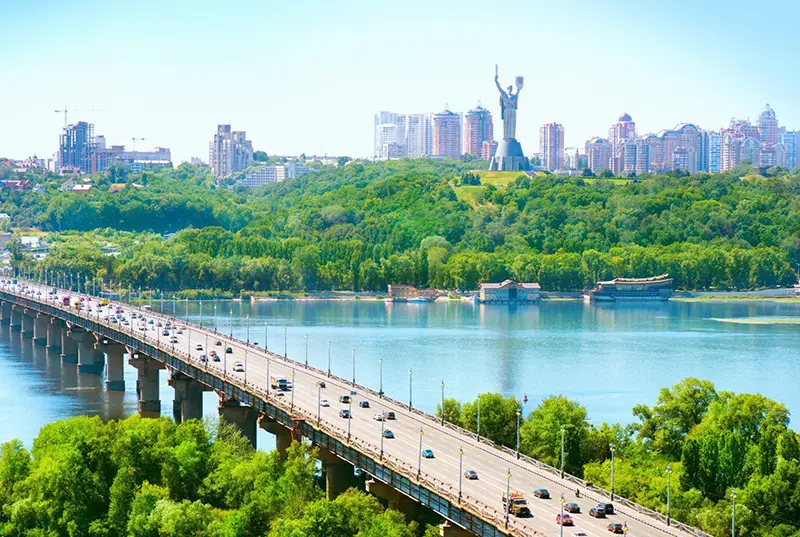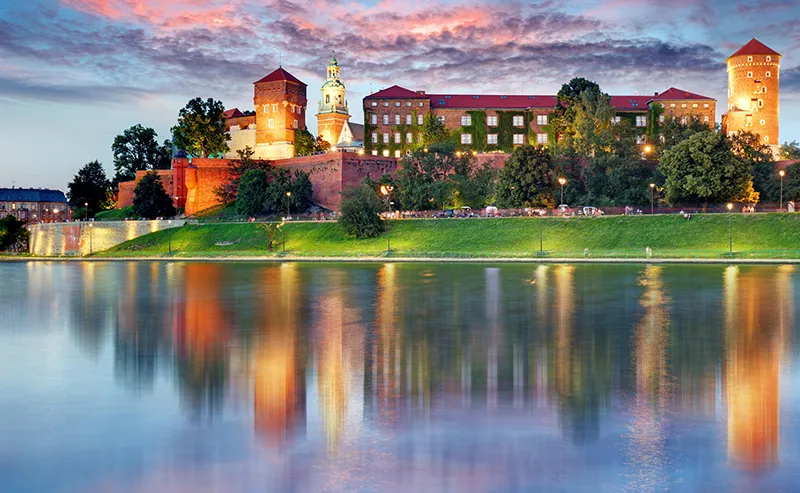Kyiv is the capital and heart of Ukraine, a city with centuries-old history, combining ancient temples and modern skyscrapers. The grandeur of Kyiv-Pechersk Lavra, the energy of Khreshchatyk and the coziness of St. Andrew’s Descent coexist here. The Dnieper River gives the capital a special atmosphere, and the developed infrastructure makes it convenient for life and tourism.
History of the city
According to the “Tale of Bygone Years” written in the XII century by the monk Nestor in the Kyiv-Pechersk monastery, Kyiv was founded by the Polanyi princes-brothers Kiy, Shchek, Horiv and their sister Lybidya. The city was named after the eldest of them. Although this version of the origin of the name of the city is the most popular, but far from the only one. In the XIX century, many historians generally denied it, leaning towards the Sarmatian origin of the city. However, archaeological excavations proved that Kyiv was founded by Slavs and it happened approximately in V-VI centuries.
In 882 Oleg (Prophetic), the prince of Novgorod, invaded Kyiv and, having killed the princes Askold and Dir who ruled there, declared the conquered city to be the capital of the state of Kyivan Rus and the “Mother of Russian Cities” – so he poetically assessed the strategic location of the city and its role in the future. Gradually the princely residence became richer and more beautiful. At the end of X – beginning of XI century stone houses began to appear in the streets of the city, the first churches were raised (Prince Vladimir Svyatoslavich baptized Russia in 988), and powerful defensive constructions stretched along the borders of the capital city. And in 1051, under Yaroslav the Wise, the first monastery in the history of Kyivan Rus appeared here, now known as the Kyiv-Pechersk Lavra.
The prosperity of Kyiv was triumphant, bright, but, alas, not long. Already in the XII century Kyivan Rus split into several principalities and the former capital lost its power. This was only the beginning of Kyiv’s troubles. The element of internecine wars did not bypass the Kyivan principality: in 1169 the troops sent by the Grand Prince of Vladimir Andrei Bogolyubsky (1111-1174) ravaged Kyiv, robbing and killing its inhabitants. The next crushing blow to the city was dealt in 1240, when the hordes of Mongol-Tatars swept across Kyivan Rus’ in a wave – Kyiv was again left in smoking ruins. In the XIV century, the territory of Kyiv became part of the Grand Duchy of Lithuania, and in 1569 it was ceded to the Polish-Lithuanian Commonwealth (a federation of the Kingdom of Poland and the Grand Duchy of Lithuania), later remaining in the possession of Poland. At the Pereyaslav Rada, Russia concluded a treaty with the Polish Kingdom, one of the clauses of which was the return of Kyiv.
In 1917-1918. Kyiv was subordinated to the Ukrainian Central Rada of the Ukrainian People’s Republic. On February 8, 1918 it was taken by the Red Army, but in April of the same year it again became the capital of the Ukrainian People’s Republic under Petliura, until August 31, 1919 during the Civil War it was again occupied by the Red Army. The capital of the Ukrainian SSR then became Kharkiv; it transferred this authority to Kyiv in 1934.
The events of the 20th century completely transformed the appearance of Kyiv. After the battle for the city in 1941, its historic center was almost completely destroyed by explosions and fires provoked by them (during the retreat, the Soviet troops mined the German-occupied territories to destroy all communications and housing). Even Khreshchatyk (the main street of Kyiv, founded in the early XIX century) was literally wiped off the face of the earth. But already in 1943 Kyiv citizens undertook to restore it. The modern city center, rebuilt in the post-war years, is in the style of the so-called Soviet classicism. The former low houses were replaced by monumental multi-storey architecture, traditional for that era, which was supposed to symbolize the power and steadfastness of the Soviet Union.
In 1981 a memorial complex was opened at the Museum of the Great Patriotic War in Kyiv, the crown of which is the 80-meter high monumental sculpture “Motherland”. It is personified by a female figure raising a shield and sword to the sky. In the building forming the pedestal of the statue, there is a Hall of Fame: here on the walls of separate rooms are immortalized the names of military units, partisan detachments and the names of war heroes who stood up to defend the capital of Ukraine from the invaders.
Kyiv now
In 1991, Kyiv entered a new historical era, becoming the capital of independent Ukraine. Having survived the turmoil of the political crisis, Kyiv set a course towards the level of European capitals.
Its special grandeur is now emphasized by modern evening illumination of the main streets and squares. One of these squares Maidan Nezalezhnosti, or Independence Square, is a favorite meeting place for Kyiv citizens.
Here on holidays popular festivities are held, and local residents come here to defend their civic position. Independence Square became especially famous outside the country in the fall of 2004, during the “Orange Revolution”, initiated at that time by the future president Viktor Yushchenko. At that time all the world’s information channels broadcasted reports about the rallies of thousands of people not only from Kyiv, but also from all regions of Ukraine, who disagreed with the results of the presidential election. Since then, the main square of Kyiv has become the democratic tribune of the country, a truly national assembly. More than once Maidan has been filled with crowds of people, supporters or opponents of the next steep turn in the political life of Ukraine, and often both at the same time. They are no longer rallying under orange banners. And no one knows what banners will be established in Kyiv in the end.
Kyiv, as a true megalopolis, has been and remains a multinational city. It continues to develop as a major industrial, cultural and educational center. Open to new trends, among which it favors Western technology for the economy and European style for life.
Russia’s invasion of Ukraine
Kyiv, as the capital of Ukraine, became a key symbol of resistance during the Russo-Ukrainian War. From the first days of the full-scale invasion in February 2022, the city was under threat of capture, but thanks to an organized defense and the support of the international community, Russian forces were unable to take it. Today Kyiv remains the political, economic and military center of the country, surviving shelling, adapting to military realities and continuing its struggle for independence.
General Information
- The capital of Ukraine, the city-eroy.
- Administrative division: 10 districts.
- Languages: Ukrainian.
- Religion: Orthodox Christianity, other Christian denominations, Muslim, Jewish and Buddhist communities.
- Currency unit: hryvnia.
- Rivers: Dnieper, Lybid, Syrets (tributaries of Dnieper).
- The most important airport: Boryspil international airport.
- Area: 839 km2.
- Population: 2,785,825 (2010).
- Population density: 3,320.4 people/km2.
Economy
- Industry: light industry, food industry, printing, metallurgy, machine building, aircraft building.
- Service sector: tourism.
Climate and weather
- Moderate continental.
- Average winter temperature: -4.3ºС.
- Average summer temperature: +19.5ºС.
- Average precipitation: 621 mm.
Attractions
- Monument to the founders of Kyiv;
- Kyiv-Pechersk Lavra;
- Golden Gate;
- St. Sophia Cathedral;
- St. Vladimir’s Cathedral;
- Mariinsky Palace,
- “House with Chimeras”;
- Podol historical district;
- Andriyivsky Descent;
- National Historical Museum of Ukraine;
- Archive-Museum of Art and Literature of Ukraine;
- Mikhail Bulgakov Museum;
- National Museum of Chernobyl;
- Kirillov Heights (cave monastery, Babi Yar).
Fun Facts
- During archaeological excavations of settlements of the IX-XIII centuries in what is now Kyiv, more than eight thousand tools of iron were found, as well as castles, weapons, parts of military armor, household items, horse harness, elements of clothing – this is what concerns iron. And more than three thousand jewelry made of gold, silver and various alloys with them. Interestingly, all of them are forged or made extremely carefully and skillfully. But even more interesting is that Kyiv metal artists – both blacksmiths and jewelers – are famous for their decorative style even today.
- In 1892, Kyiv became the first city where a streetcar was launched – the first route ran along Alexandrovsky Spusk. Since 1905 a funicular has been operating in the city, connecting Podol and Upper Town districts.
- At the end of the X century, during the reign of Prince Vladimir Svyatoslavich (the Great) (960-1015), the first stone church in the history of Kyivan Rus was built in Kyiv. It was called the Church of the Dormition of the Most Holy Mother of God, or the Church of the Tithe. It was destroyed twice, and work is currently underway to restore it.




